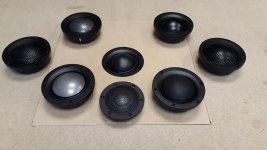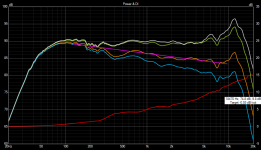Mid is Wavecor WF120BD04, tweeter is Dayton AMT3-4.
The cat is much more interested in our house plants than the speakers, it’s our dogs I have to worry about when they wrestle .
must be those military stripes warding off the cats. Lol
Are you crossing those amts passively, and if so, how do you deal with the esrly HF roloff?
Beautiful job for sure both speaker sets look very interesting -embarrassing for me I have not heard these AMT Dayton AMT3-4 or any ��.
This is what I did with them 😉
Those are stunning pieces of work. Kudos!
Member
Joined 2003
Thanks everyone for the kind comments, this speaker was a very ambitious project for me, my best work to date. If it isn't obvious, the baffle is solid African mahogany, with maple inlay, and the sides are maple veneer. Not photographed is a CSS APR12 passive radiator on the back.
The key is to not focus too much on single axis response. I tried a few different things, but found what sounds best is to follow VituixCAD CTA-2034-A method and tune for constant slope of in-room and power response. Screenshot attached. You will see, that most of the natual rising response of the AMT is left in place here, but in-room and power response are flat to 10kHz as a result of the tweeter directivity profile and crossover involved. It is not perfection, unfortunately the very top end performance of the AMT is the weak link in this speaker, but it is still incredibly enjoyable to listen to, the tonality through the midrange and bass is perfect.
In the screenshot, don't read too much into the midbass response, it is real hard to get accurate measured data with woofer at floor level, as well the PR output is not included here for the bass performance <100Hz. On the other end of the spectrum, the wiggle at 7kHz was only present in one of my AMTs, the other measures perfectly without the wiggle. I even went as far as to disassemble and inspect them, but I couldn't see any problem, reassembled and nothing changed. My ears cant tell the difference between the two tweeters when listening so I am not very concerned.
Ok..back to the thread, sorry to derail a bit.
Are you crossing those amts passively, and if so, how do you deal with the early HF rolloff?
The key is to not focus too much on single axis response. I tried a few different things, but found what sounds best is to follow VituixCAD CTA-2034-A method and tune for constant slope of in-room and power response. Screenshot attached. You will see, that most of the natual rising response of the AMT is left in place here, but in-room and power response are flat to 10kHz as a result of the tweeter directivity profile and crossover involved. It is not perfection, unfortunately the very top end performance of the AMT is the weak link in this speaker, but it is still incredibly enjoyable to listen to, the tonality through the midrange and bass is perfect.
In the screenshot, don't read too much into the midbass response, it is real hard to get accurate measured data with woofer at floor level, as well the PR output is not included here for the bass performance <100Hz. On the other end of the spectrum, the wiggle at 7kHz was only present in one of my AMTs, the other measures perfectly without the wiggle. I even went as far as to disassemble and inspect them, but I couldn't see any problem, reassembled and nothing changed. My ears cant tell the difference between the two tweeters when listening so I am not very concerned.
Ok..back to the thread, sorry to derail a bit.
Attachments
I'm glad you chose mahogany for the baffle.
It has been used for large cameras and other optical devices for several score of years, for its dimensional stability and relatively low transmission of vibration.(it is considered a 'tone wood', but a soft mellow one)
Stain-friendliness doesn't hurt, either.
lovely work, in any case.
It has been used for large cameras and other optical devices for several score of years, for its dimensional stability and relatively low transmission of vibration.(it is considered a 'tone wood', but a soft mellow one)
Stain-friendliness doesn't hurt, either.
lovely work, in any case.
Member
Joined 2003
Thank you. No stain here, it is tung oil with a gel poly coat on top for added durability.
I put a couple battens on the inside of the baffle to help prevent any warping, and it is attached with gasket and screws from behind, no glue on the baffle. It's been over a year now with no visible changes whatsoever so I think my assembly process was good for the solid baffle.
I put a couple battens on the inside of the baffle to help prevent any warping, and it is attached with gasket and screws from behind, no glue on the baffle. It's been over a year now with no visible changes whatsoever so I think my assembly process was good for the solid baffle.
Last edited:
I don't think too many would mind -bloody amazing job and I am sure you are not missing too much with that AMT top end -Dayton worked with PBS loudspeakers to create a reference design with this driver a few years back and it was supposed to sound terrific -bright red. Thanks for showing part of the design phase
The measurements of the Seas T29CF002 (E0040-06) "Crecsendo" tweeter:
Seas T29CF002 (E0040-06) "Crecsendo" | HiFiCompass
Seas T29CF002 (E0040-06) "Crecsendo" | HiFiCompass
Member
Joined 2003
Nice tweeter, but wow its expensive. Not sure it's "better" than Scan D2905/9700 or 9900 which are cheaper.
@HiFiCompass
Is there any chance that you will do measurements of following drivers
1. Sb Acosutics SB26CDC
2. Tang Band W6-1139
3. Dayton Audio E180HE
4. Scan-Speak D2604/833000
Is there any chance that you will do measurements of following drivers
1. Sb Acosutics SB26CDC
2. Tang Band W6-1139
3. Dayton Audio E180HE
4. Scan-Speak D2604/833000
Member
Joined 2003
1. It's the same as SB26ADC, so there's no plans to test it.
2. I have no opportunity to get this speaker
3. The same as #2
4. There's no plans
2. I have no opportunity to get this speaker
3. The same as #2
4. There's no plans
Thank you a lot1. It's the same as SB26ADC, so there's no plans to test it.
2. I have no opportunity to get this speaker
3. The same as #2
4. There's no plans
The measurements of the Seas T29CF002 (E0040-06) "Crecsendo" tweeter:
Seas T29CF002 (E0040-06) "Crecsendo" | HiFiCompass
Thanks this driver I really was looking forward to the test - it was popular in Australia years ago in your opinion does it still stand up today with the best tweeter's ? And what stopped a 5 star rating was it the cost or linearity appreciate your response. It is listed at $640 each in Peso dollar Australia now -ooch ! I am not seeing that kind of performance. Did you listen to it ? And could you see you ever using it in a design?
cheers
also noticed this today AT60NC-4 AT60NC-4 Satori Tweeter Air Motion, Speaker Drivers | Wagner Online Electronic Stores anybody used these?
I suggest 9800 then 9700.....Nice tweeter, but wow its expensive. Not sure it's "better" than Scan D2905/9700 or 9900 which are cheaper.

?????, ?????????, ??????????? ???????. - ???????? 96
Found a new pic of the Bliesma domes. Hope they land soon and have nice measurements (for hificompass to conifrm).
If the 3" soft dome/paper/aluminium could do 750hz-4khz with LR2 either end and low enough distortion and for $200-250 then they would make a killing.
They'd have my cash in a heartbeat! Though, I'd be happy with 3khz. In the meantime, I'm tempted by the Kartesian Wom120, which strikes me as a bargain.
- Home
- Loudspeakers
- Multi-Way
- Some speaker driver measurements...
